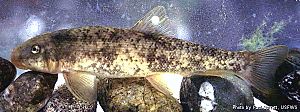Santa Ana sucker facts for kids
Quick facts for kids Santa Ana sucker |
|
|---|---|
 |
|
| Conservation status | |
| Scientific classification | |
| Synonyms | |
|
The Santa Ana sucker (Catostomus santaanae) is a special kind of fish that lives only in freshwater. It is found only in California, making it an endemic species. This fish is related to the mountain sucker. It has a dark grey back and shiny silver belly.
The Santa Ana sucker can grow up to 25 centimeters (about 10 inches) long, but most adults are smaller. It eats tiny plants like algae and diatoms, along with dead plant and animal bits (called detritus) from the bottom of shallow streams. These streams usually have sand, gravel, or small rocks. This fish lives in only a few streams in southern California. Many of these streams in the Greater Los Angeles area have been changed into concrete channels. Because it lives in such a small area and is easily harmed, the International Union for the Conservation of Nature has listed this fish as "endangered".
Contents
About the Santa Ana Sucker
The Santa Ana sucker looks a lot like its relative, the mountain sucker. Its top part is dark grey, and its bottom part is silvery-white. Its sides might have faint, darker spots and lines.
This fish has special notches where its upper and lower lips meet. The lower lip is narrower in the middle and has only a few rows of small bumps called papillae there. Its back fin (dorsal fin) has 9 to 11 rays, and its belly fins (pelvic fins) have 8 to 10 rays. The part of its body just before the tail (caudal peduncle) is a bit long. Unlike the mountain sucker, the skin between the rays of its tail fin has color. While some have been measured up to 25 centimeters (10 inches), most Santa Ana suckers are usually less than 16 centimeters (6 inches) long.
Just like the mountain sucker, this fish eats diatoms, other types of algae, and detritus. It gets this food by scraping it off surfaces like rocks. Sometimes, it also eats insect larvae. Bigger fish tend to eat insects more often.
Where They Live
These suckers live in smaller streams that are always flowing. These streams are usually less than 7 meters (about 23 feet) wide and can be anywhere from a few centimeters to over 1 meter (3 feet) deep. The water needs to be cool. The speed of the water flow can change, but the fish seem to prefer clear water. However, they can handle water that is a bit cloudy. Since they scrape food off surfaces, they like stream bottoms made of gravel, small rocks, or larger boulders.
Their California Homes
The Santa Ana sucker lives in a very small area. They are naturally found only in the Los Angeles River, San Gabriel River, Santa Ana River, and Santa Clara River systems in Southern California. Sadly, they have disappeared from many parts of these rivers.
Now, they are only found in a few specific places:
- Big Tujunga Creek in the Los Angeles River Basin.
- The upper parts of the San Gabriel River in the San Gabriel Mountains, which are inside the Angeles National Forest in Los Angeles County.
- Parts of the Santa Clara River system in Los Angeles and Ventura counties.
- The lower part of the Santa Ana River in Orange County, especially where clean water from water treatment plants flows into the river.
Protecting the Santa Ana Sucker
Some parts of the rivers where these fish live are wild and protected, especially those within the Angeles National Forest. However, the Santa Ana sucker's home is also right in the middle of the huge Greater Los Angeles area. Many of the streams they live in have been turned into concrete flood control channels. This makes them a vulnerable species and at risk of extinction.
The International Union for the Conservation of Nature has officially listed this fish as an "endangered species". This is because the area where they live is getting smaller, and their population is decreasing. Protecting their natural stream habitats is very important to help these unique fish survive.
See also
 In Spanish: Catostomus santaanae para niños
In Spanish: Catostomus santaanae para niños


